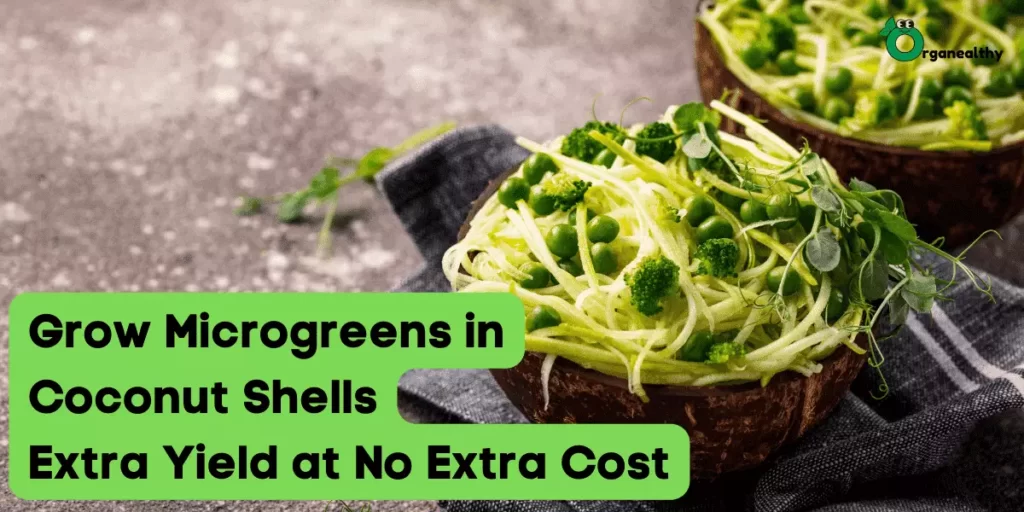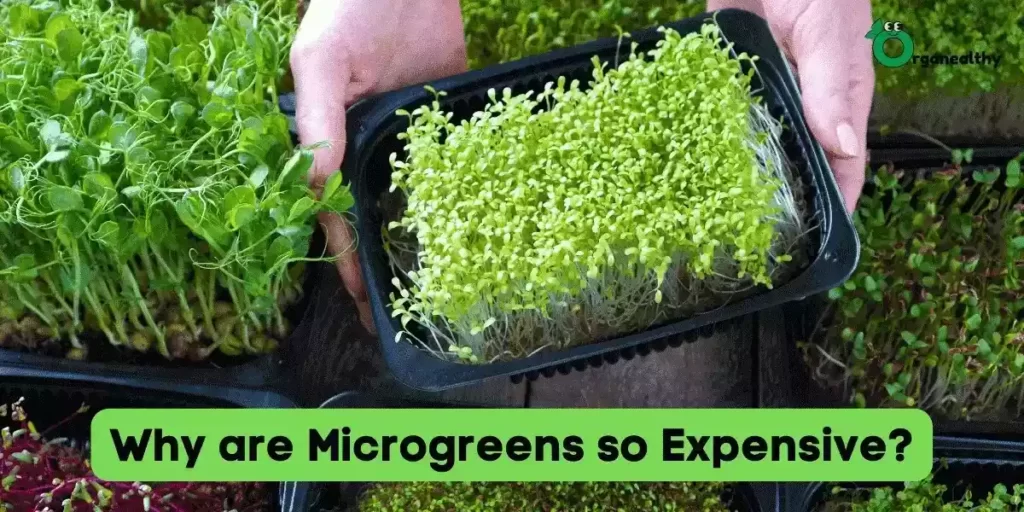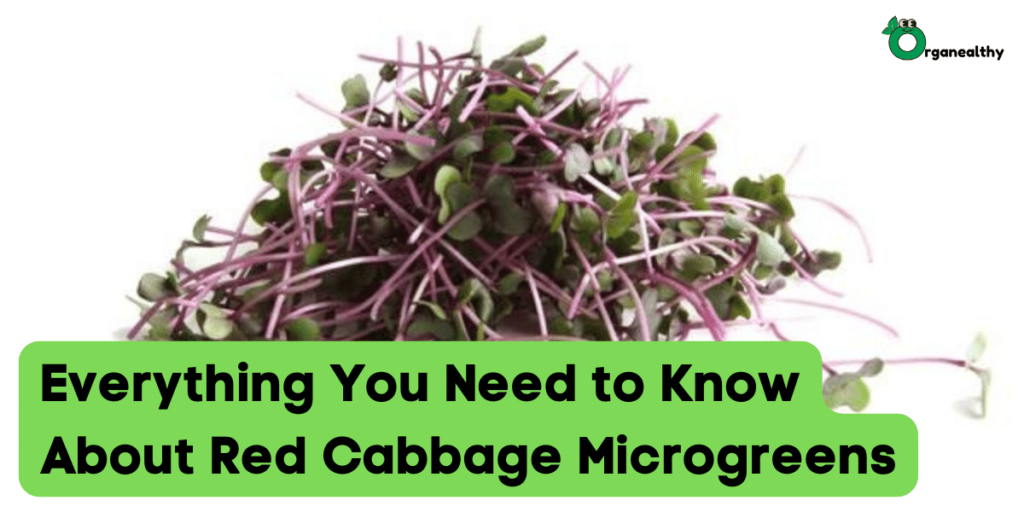Buckwheat microgreens are one of the fastest-growing microgreens. In most cases, buckwheat microgreens are ready to harvest within 7 days from planting.
Most gardeners shy away from growing buckwheat microgreens, also known as buckwheat lettuce, because of their seed hulls, as they are hard to come off. However, in this complete guide, I will show you how to grow buckwheat microgreens easily.
We will also discuss the nutrients and health benefits of buckwheat microgreens.
So, let’s jump into the article.

Essentials for Buckwheat Microgreens
Before jumping into how to grow buckwheat microgreens, let me share the essentials you need to collect before getting your hands dirty.
Buckwheat Microgreen Seeds
The seed quality of your microgreens is the most important element of growing any microgreens. If the seed quality is bad, the microgreens won’t grow at all. Or worse, they will get infested with mold.
In my opinion, the best place to buy buckwheat microgreens seeds is True Leaf Market. They provide high-quality non-GMO seeds that yield a healthy batch of microgreens.

True Leaf Market provides 3 variants for buckwheat seeds – sprouting, microgreens, and cover crops. So, make sure you choose the microgreen variant. You can buy the buckwheat microgreen seeds in 3 capacities – 1 lb, 5 lbs, and 25 lbs.
Growing Trays [10inX20in or 5inX5in]
You need at least 3 growing trays of the same size to grow buckwheat microgrens. One growing tray with drainage holes to plant the seeds, one that will go under the growing tray and collect the excess water, and a third tray to cover the microgreens in the blackout period.

Preferably, the growing trays must be of the same size. You can buy a set of growing trays from True Leaf Market or Amazon – your choice.
Potting Soil Mix
You can grow buckwheat microgreens in coco coir, but since coco coir is nutrition-less, as compared to soil, your microgreens might take longer to grow and might not be as vibrant as those grown in soil.

An OMRI-certified potting soil mix is a great starting point. You can buy as much soil as you also want if you want to try growing other varieties of microgreens, like, radish or broccoli.
Miscellaneous Items
You can use a pouring jar to water your microgreens. However, there’s a risk of overwatering a part when pouring water from a jar. That’s why I suggest you get a spray bottle or a water hose nozzle with adjustable settings.
Apart from the watering equipment, you need scissors or a sharp knife to harvest the buckwheat microgreens. You can use a kitchen knife or a pair of scissors you have at home – just sterilize it before using it on your microgreens.
You also need some Ziploc bags or air-tight containers to store your buckwheat microgreens after harvesting.
How to Grow Buckwheat Microgreens?
Growing buckwheat microgreens is quite easy, it’s just the hulls that bother a lot of gardeners. But, you need the hulls, as the seeds with hulls germinate better. Buy organic buckwheat seeds to grow your microgreens, and you’ll have a fantastic yield.
Grow lights are the best lights for microgreens; more specifically, a 6500K LED grow light works best for any variety of microgreens. A grow light fitted directly above the growing tray helps the buckwheat microgreens grow nicely and uniformly.
Otherwise, if you keep the microgreens on a windowsill, they’d lean towards the sun and grow unevenly. So, if you are all set, let’s get moving to grow buckwheat microgreens.
Soak Seeds for 12 to 24 Hours
Buckwheat microgreen seeds should be soaked in cold water for at least 12 to 24 hours. Once soaked, be sure to rinse them thoroughly before planting them.
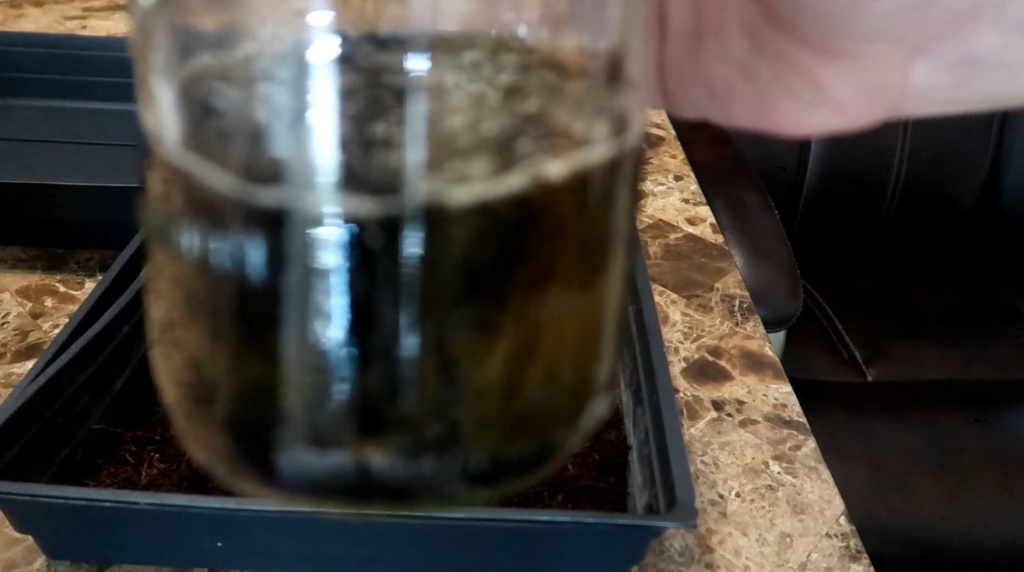
Prepare your growing tray by spreading out the potting soil mix evenly across the tray. You can even put the soil through a sieve to remove the debris or lumps in the soil.

Rinse out the water and spread the soaked seeds evenly across the tray. Lightly run your hand over the seeds to avoid any overlapping of the seeds. I used 8 tablespoons of buckwheat seeds for a 10inX20in growing tray.
You can softly press them down or add another layer of soil over the seeds.

The upper layer of soil helps shell off the hulls when the seeds start germinating. Hence, I strongly recommend you add a layer of soil over the seeds.
Blackout Period & Germination (2 to 3 Days)
Use a spray bottle to water your buckwheat microgreens. Place a growing tray over the seeds and keep weight over it to press them deeper into the soil. Do this for 1 or 2 days. This is the blackout period where your microgreens do not get direct light. Keep watering once a day.
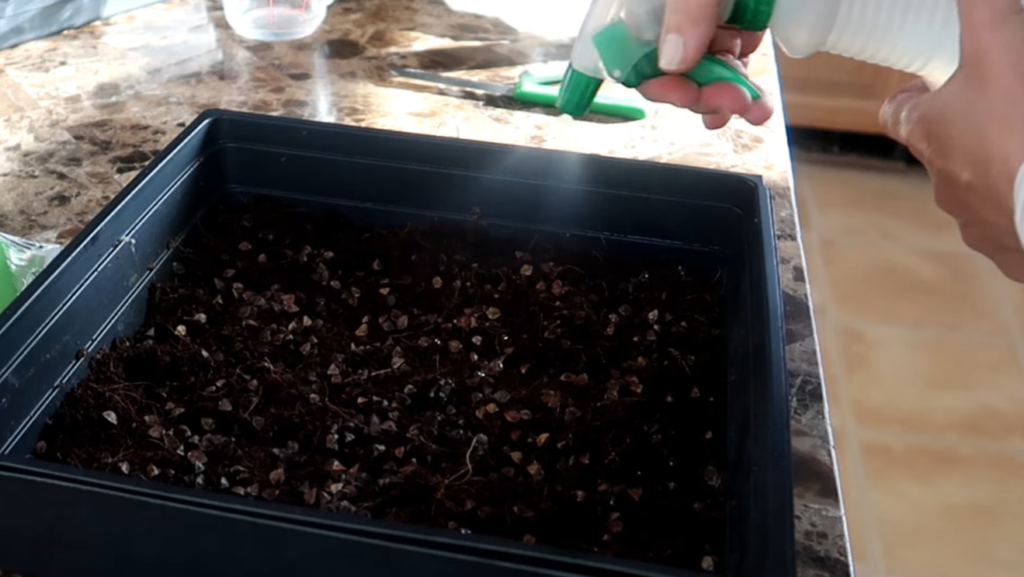
After 2 to 3 days, this is how your buckwheat microgreens will look like. The seeds will start sprouting, and the hulls will start coming off naturally.
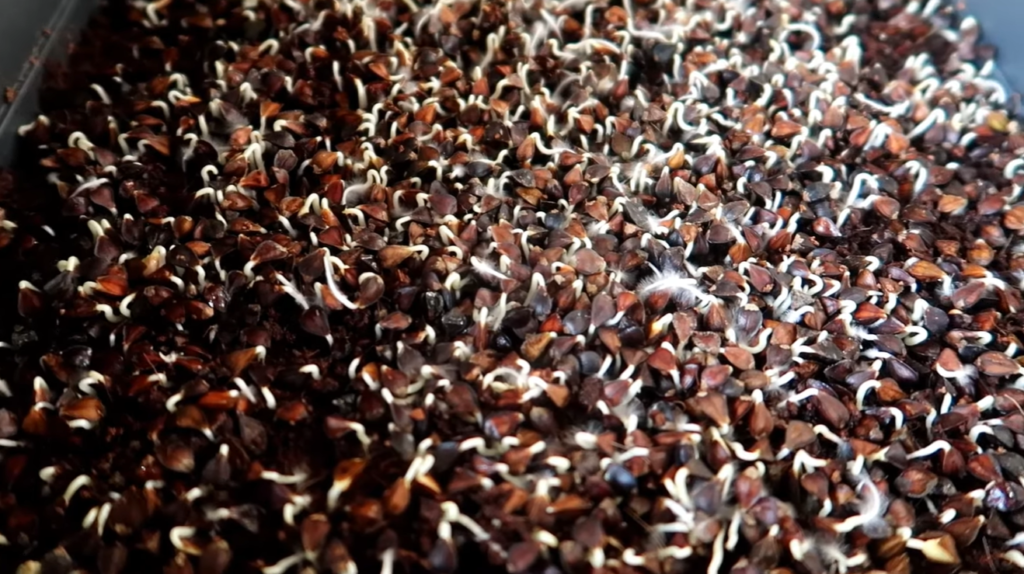
When you place a growing tray and weight over it, the hulls come off much more easily. This way, at harvest time, you will hardly have any hulls.
Harvest Time
After 7 to 10 days of growing buckwheat microgreens, they are ready to harvest. If the hulls have not come off, let them grow more for a day or two, and the hulls will come off. Or else, rub your hands over them slightly to remove as many hulls as possible.
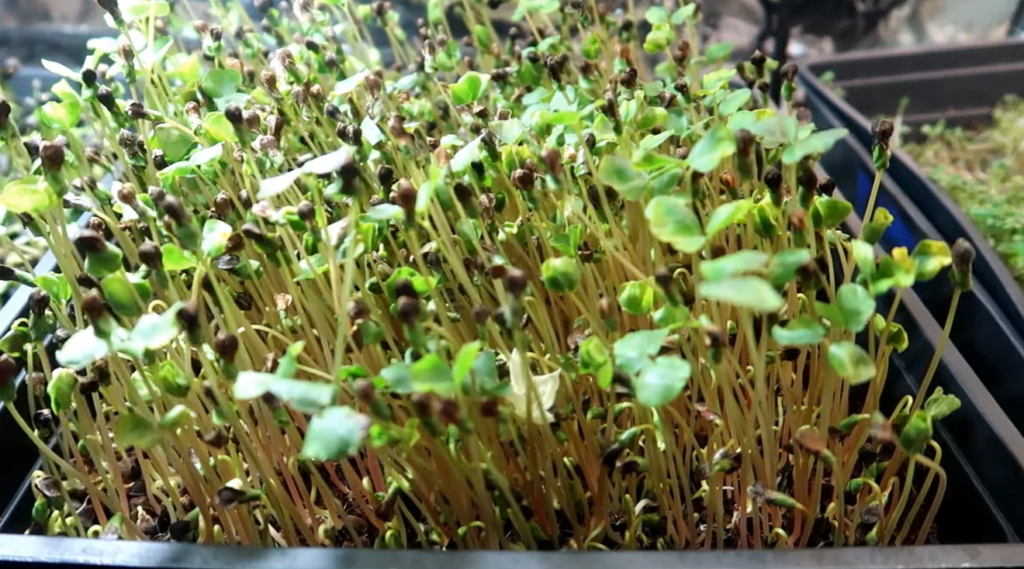
You must harvest your buckwheat microgreens when they’re 2 to 4 inches tall because that’s when the flavor, texture, and nutrients are at their best. Once the first true leaves grow, the plant gets tough and bitter.
Now, it’s time to grab your scissors or a sharp knife and harvest your buckwheat microgreens. Cut just above the soil level. You can harvest some of the grown buckwheat microgreens and save the rest for later.
But remember, there’s a small amount of time when they’re just right for eating.
Store in an Air-Tight Container
Once buckwheat microgreens are harvested, store them in a Ziploc bag or an air-tight container. Storing microgreens in a dry condition is crucial to extend their shelf life.
Here are a few things to remember before storing your microgreens.
- Microgreens should be healthy and fresh, not wilted.
- They must not be damaged during harvesting.
- Do not store wet microgreens; if they are, they will rot.
If you are growing microgreens without soil, you will have an easy time harvesting. However, if you have a soil-grown harvest, please ensure there is as little soil as possible on the microgreens.
Once you harvest the microgreens, quickly put them in an air-tight container. Then, put the container or the bag in the refrigerator.
How Do Buckwheat Microgreens Taste Like?
Buckwheat is more popular in the form of groats or noodles, but not many consumers like its bland taste. Buckwheat microgreens taste mildly citrusy; the earlier you harvest them, the tangier they taste.
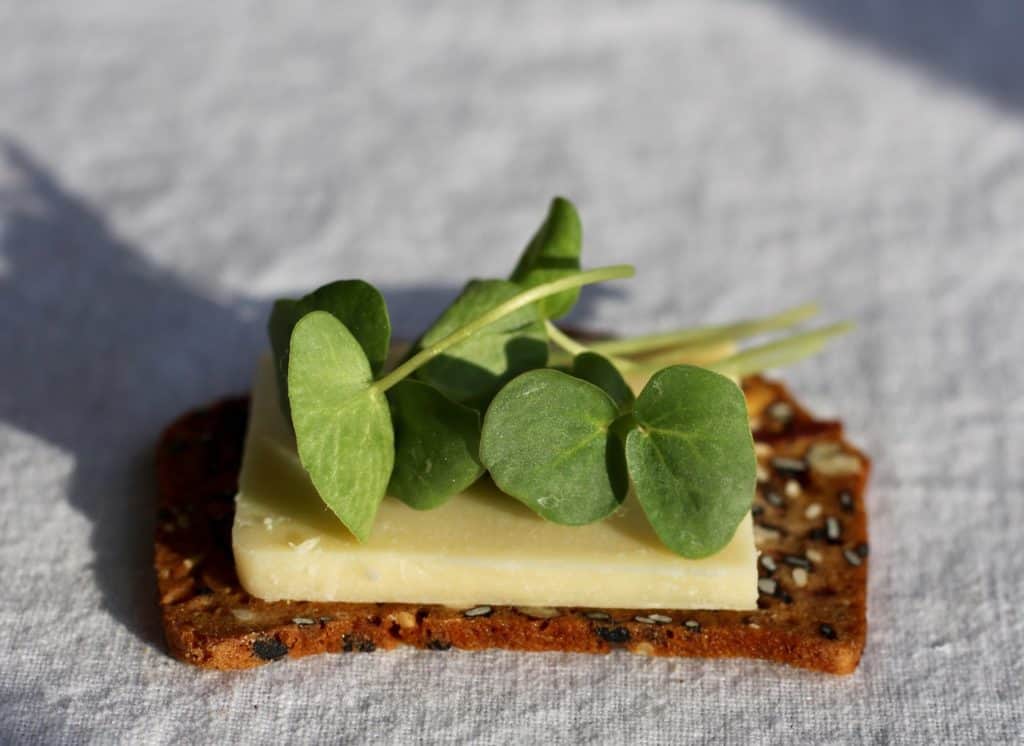
You can experiment with your microgreens by growing them in small batches, like growing microgreens in coconut shells and then harvesting them at multiple stages. This way, you can find a taste that suits your taste buds.
Nutritional Value
These tangy buckwheat microgreens do not just taste good but are also full of nutritional value. Buckwheat, in general, is gluten-free and helps in slowing down glucose absorption, making it a must-have for diabetic patients.
Buckwheat microgreens are known to be rich in vitamins A, B6, and C, Iron, Potassium, Calcium, Lecithin, Magnesium, Chlorophyll, Amino Acids, Enzymes, and more.
Here’s a comprehensive table that shows you how much nutrition one 100g serving of buckwheat provides you.
| Nutrient | Amount | Unit |
|---|---|---|
| Energy | 335 | Kcal |
| Carbohydrates | 70.6 | g |
| Protein | 12.6 | g |
| Total Fat | 3.1 | g |
| Cholesterol | 0 | mg |
| Dietary Fiber | 10 | g |
| Calcium | 41 | mg |
| Copper | 0.515 | mg |
| Iron | 4.06 | mg |
| Magnesium | 251 | mg |
| Manganese | 2.03 | mg |
| Sodium | 11 | mg |
| Phosphorus | 337 | mg |
| Potassium | 577 | mg |
| Zinc | 3.12 | mg |
| Folates | 54 | µg |
| Niacin | 6.15 | mg |
| Pantothenic acid | 0.44 | mg |
| Riboflavin | 0.19 | mg |
| Thiamin | 0.417 | mg |
| Vitamin B-6 | 0.582 | µg |
| Vitamin E | 0.36 | mg |
| Vitamin K | 7 | µg |
| Tryptophan | 0.183 | g |
| Threonine | 0.482 | g |
Source: Food Data Central (US Department of Agriculture)
According to a study published on the National Library of Medicine website, an average male needs 2500 calories daily to maintain his body weight. For a female, the calorie requirement is 2000 calories.
In that respect, buckwheat provides 335 calories per 100g, so buckwheat microgreens supply 14% of the daily energy requirement for males and 17% of the daily energy requirement for females.
The abundance of fiber regulates your digestion system and keeps your gut healthy. The high amount of protein, which most healthy microgreens have, helps in the development and repair of tissues.
Health Benefits
The vast nutrients of buckwheat microgreens provide a lot of health benefits. Let’s see the major health benefits of consuming this superfood.
Improves Gut Health
Dietary fiber is crucial for a healthy gut, and buckwheat microgreens have an abundance of it. It helps with digestion, encourages regular bowel movements, and helps the growth of good bacteria in the stomach.
Regulates Blood Sugar
Buckwheat microgreens are low on glycemic index, which means they help regulate blood sugar levels. This makes buckwheat a perfect choice for diabetic patients or people trying to control their blood sugar.
Additionally, buckwheat microgreens contain fiber and phytochemicals, which enhance insulin sensitivity.
Anti-Inflammatory Properties
Antioxidants help fight the free radicals in the body, which eventually reduces stress and cortisol. Buckwheat microgreens contain antioxidants such as rutin and quercetin, which lower inflammation and enhance heart health.
According to medical studies, various diseases, such as cancer, diabetes, and heart diseases, are linked with chronic inflammation. Buckwheat microgreens are filled with anti-inflammatory qualities and may reduce inflammation.
Strengthens Your Cardiovascular System
Buckwheat microgreens are filled with rutin – a bioflavinoid and a powerful antioxidant – and thus help build collagen and prevent atherosclerosis by maintaining the flexibility of the arteries.
Buckwheat microgreens also lower LDL cholesterol, thus keeping you immune to cardiovascular diseases.
🔔 Note: This is not a medical advice. Although microgreens are super-nutritional and have a lot of health benefits, there is still a lot of research needed in the field of microgreens.
That’s why I recommend consulting with a healthcare professional or a nutritionist before introducing microgreens into your daily diet.
Can You Eat Buckwheat Microgreens Daily?
Although buckwheat contains a lot of healthy nutrients, it also contains fluorescent phototoxic fagopyrins, which may cause fagopyrism. It is a medical condition that may cause upset stomach, skin redness, skin itchiness, and more.
A study published on the ACS Publications website suggests that buckwheat seeds, flour, and teas are safe in normal amounts. So, eat buckwheat microgreens moderately but not daily.
How to Eat Buckwheat Microgreens?
Buckwheat microgreens add a touch of freshness and tangy flavor to your meals. Here are some ways you can eat buckwheat microgreens:
- Garnish your dishes with buckwheat microgreens to elevate your meal’s visual appeal and nutritional value.
- Try one of the microgreens salads with buckwheat microgreens. Or, use them on wraps and sandwiches as a nutritious and flavorful topping.
- Add microgreens to your stir-fries or sautés at the last moment to preserve their delicate texture and add freshness.
- Want to have a nutritional microgreen juice? Blend buckwheat microgreens into your favorite smoothie or juice.
Even if you’re just looking for a quick snack, these microgreens can be the best option out there. One serving is sufficient to provide you with the nutrients you need and make you feel full before you leave your home for the day’s work.
Final Thoughts
In summary, embrace the transformative power of buckwheat microgreens as a nutritional powerhouse, enriching both flavor and well-being.
Incorporate these greens into salads, sandwiches, smoothies, and pesto for a vibrant and healthful culinary experience. Cultivating buckwheat microgreens is a convenient and accessible journey, offering not just homegrown freshness but also valuable insights into the cultivation process.
If you want to get a headstart in growing microgreens without making a mess, then I suggest you try a microgreens growing kit today!



